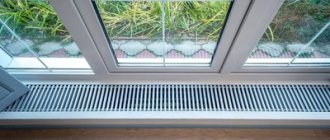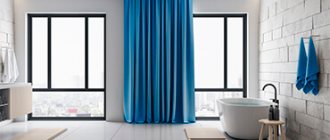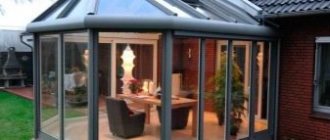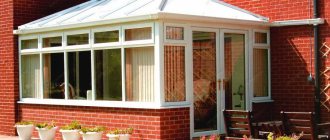We have been familiar with the frightening word “draft” since childhood. It most often causes us to associate it with colds and illness.
Everyone knows that you need to stay away from drafts. Many people know that it is better not to allow them in a house or apartment, and if they do appear, then it is necessary to fight them. But in what ways? Not everyone knows about this.
Moreover, few will even be able to clearly explain why drafts appeared in the house. How to eliminate something whose cause is unknown?
To understand this, let's then dwell on the physical foundations of this phenomenon; for this, the knowledge in physics obtained at school will be quite enough for us.
Draft: what is it?
A draft is the movement of air currents in a closed room if there are cracks, open windows or doors. Some believe that drafts appear when there are entry and exit points for the air flow that are directed opposite each other. Example: if you open a window that is opposite an open door.
But such a condition is not necessary for a draft to appear. In addition, this is not the only culprit for this problem.
The main reason for the appearance of drafts is the difference in the physical properties of air (its temperature and pressure) inside and outside the building.
The greater the difference, the air flows will begin to move at a higher speed.
Some may be confused by this fact: we are not in a pressure chamber, the pressure is atmospheric both outside and inside the building. But you don’t need too much difference for a draft to appear! A light blow of wind along the length of the outer wall of the building already creates an area of rarefaction of air. If you open a window in the wall, warm air from the house will rush into this place.
Why do walls freeze and how to deal with it?
Why does the roof freeze and how to deal with it?
Often the corridor plays the role of a pipe that exhausts air. This is exactly the phenomenon that can be observed when opening the front door.
Temperature difference is another criterion that affects the occurrence of drafts in a house or apartment. Those who didn't skip physics classes at school remember that bodies expand when they are heated. And the pressure of the warm air flow is higher than the pressure of the cold air flow.
A heated building is always warmer than outside. When the window is opened, warm air flows will begin to “escape” outside, and a cold air flow will take their place.
It is known that warm air is lighter than cold air. That is why jets of cold air, having penetrated the building, rush to the floor, and it begins to “blow on our feet.”
People whose desk is located near a window often have to deal with one manifestation. It does not directly, but still indirectly relate to drafts. And it is connected with the movement of warm and cold air masses. The window seems to be plastic, with a good profile and a sufficient number of double-glazed windows, and maybe even energy-saving, but it still “breathes cold.” This manifests itself because the cooling of the air near the window is much more intense than that of the air near the wall, and this does not depend in any way on the quality of the window construction.
Therefore, air flows always circulate more intensely near the window. And we feel it.
For people and animals
For people, local hypothermia is primarily fraught with diseases such as colds, myositis or muscle spasms, as well as neuralgia. That’s what people say – “it’s blown”. Depending on where a person has a weak point, a draft can “hit” the ears and nose, kidneys, pelvic organs, muscles, etc. Decreased immunity can provoke an exacerbation of chronic diseases, such as herpes. So the danger should not be underestimated; even a common cold, if not treated sufficiently, can cause complications.
Animals are also very sensitive to air currents. If there is a draft in the room, dogs, cats, birds, etc. may get sick if the resting places are placed incorrectly. This is especially true for the latter, as well as short-haired pets and those who are completely devoid of hair. Drafts are also especially dangerous for those whose immunity is reduced due to natural reasons - for very young or older animals. Therefore, you need to ensure that the cage or bed is raised above the floor by at least ten centimeters - this will reduce the danger.
How to beat drafts?
We have found out the origin of drafts, now we will figure out how to deal with these unpleasant processes and whether there is a chance to completely defeat them.
Unfortunately, it is impossible to completely get rid of drafts. Of course, if we are talking about houses and apartments with windows and doors. Above we have given only a few reasons for the occurrence of drafts, but in reality there are many more. Identifying and preventing them all is not at all easy.
But it is possible to identify the sources of drafts and reduce them to a minimum, or eliminate them when it comes to the design stage of a building.
Sealing the holes through which the pathological movement of air masses occurs can save money on heating the building and help get rid of constant colds that arise due to the uncomfortable climate in the house or apartment.
Many home and apartment owners think that the main sources of draft problems are doors and windows. However, these are not the most common places, so it is better to start detecting them from other areas.
According to many years of observations, drafts enter the apartment through:
- walls, ceiling, floor (31%);
- ventilation openings, areas of joints between air duct pipes and walls (20%);
- fireplace chimney (13%);
- suspended ceiling (12%);
- doors (11%);
- window structures (10%);
- electrical outlets (3%).
Negative effects of hypothermia
Drafts can cause a number of health problems. Sore throat, tonsillitis, and upper respiratory tract diseases are common manifestations of the body's reactions to hypothermia. The disease will overtake you even if you are warmly dressed and wrapped in a blanket, but your head or neck is in the path of an insidious draft. Quite often, cooling of the body occurs during sleep, when a person cannot control his condition. In this case, prolonged exposure to cold air does not pass without leaving a trace, weakening the defenses and affecting various organs and areas of the body:
- In the hot summer, pleasant coolness saves us, but when a draft wind acts as a savior, the matter can end with ear inflammation. It is believed that otitis media occurs precisely because of drafts and it occurs regardless of the time of year. The disease requires urgent treatment and easily becomes chronic. Frequent hypothermia of the ears can cause perforation of the eardrum and hearing problems inevitable with this disease;
- When exposed to a draft on your face, you should worry about the facial nerves. By overcooling them, we risk acquiring a whole bunch of sores of the ears, eyes, nose, and other sensitive points;
- You should also not expose your chest to a draft. The nerve fibers of our sternum react very painfully to hypothermia, and a common reaction to cold is inflammation and intercostal neuralgia. The disease is accompanied by unpleasant symptoms - girdling pain that occurs when the patient breathes and coughs;
- By overcooling the lower back, we risk other unpleasant consequences. Drafts can cause radiculitis, pyelonephritis, and other serious diseases;
- Various myositis or muscle inflammation are a typical reaction to local cooling. A draft can affect the muscles of any part of the body. Treatment of the disease takes a long period.
Ways to eliminate drafts
- When your house has a cold attic space, the hatch from which leads to the living space, it is imperative to insulate the edges and the hatch door.
- It is necessary to pay special attention and examine all areas where pipes enter the walls of the house. All discovered cracks must be sealed.
- Lamps built into the ceiling often cause drafts in the house. Cold air flows pass through their mounting gaps, so all gaps between the lamps must be treated with a special fireproof and heat-resistant sealant.
- If your home has a fireplace, when it is not lit, use a chimney damper that prevents cold air from penetrating through the chimney into the room. To control, you need to light the paper in the fireplace and watch the movement of the smoke. If it rushes upward, then the damper does not fulfill its tasks.
- Check window structures and doors. If their installation was performed poorly, then a draft can penetrate even through new plastic windows, let alone old wooden frames or cracked doors. If we are talking about PVC windows, then if there is a draft, the seals in them need to be replaced. And the rest of the window structures need to be well treated with sealant or high-quality insulation must be provided.
- It is better to remove the window unit of the air conditioner for the winter period. If this is not possible, all cracks must be sealed.
- Check that electrical outlets are flush with the wall. Often they are the hidden source of drafts in the house.
When does it occur?
According to the laws of physics, the air moves faster the narrower the space it is in. When passing through an open window into a room, its speed increases. And the narrower the gap, the faster it will move - usually it reaches its greatest intensity right above the floor and slightly higher. If the windows are closed, but do not fit well to the frame, there will still be air blowing into these gaps. And this may be exacerbated by several other factors. Therefore, the first rule of ventilation is to open a window rather than a window. In the first case, the air will be renewed faster with a smaller decrease in room temperature. And the second, in accordance with the presence of other factors, is the following: if the window is open, the door must be closed. This rule also applies vice versa. It is especially important if the window is opposite the door. If they are open at the same time, and a person remains in the path of the flow for a long time, most likely, he will subsequently become ill. By the way, the same effect can be obtained while sitting under the air conditioner. In any case, it is not surprising that in many countries, even warm ones, they are so careful about drafts.
What is the best way to seal cracks?
To seal cracks in windows and doors, it is better to use a rubber seal with a self-adhesive base. It is budget-friendly and easy to use. To seal the gap at the bottom of the front door, it is better to use a special tire or a sealant - a “brush”.
If cracks are found in the ceiling, floor or walls, they can be sealed with polyurethane foam, puttied, or treated with a special sealant. The choice of material will be influenced by the proportion of humidity in the house or apartment.
A clearly expressed draft will make itself felt even without special methods for detecting it.
What to do if the cause of the draft is difficult to detect?
To detect small currents of cold air, try lighting a cigarette and placing it in an ashtray or on a plate. Provide adequate lighting. Then follow the wisp of smoke from afar. In those areas of the room where it is blurred, there may be cracks and gaps.
But do not forget that ventilation systems and heating radiators also produce air movement, which should not be taken into account.
About ventilation
Staying indoors for a long time without access to fresh air negatively affects a person’s well-being.
And it’s not a lack of oxygen – quite the opposite. The fact is that a large amount of substances is released into the air through human breathing and from the skin, primarily carbon dioxide. When its concentration increases, fatigue and headache appear. Without access to fresh air, symptoms will only get worse. This is why room ventilation is so important. It is necessary to carry it out all year round 2-3 times a day. In the morning, this will help renew the air that has become stagnant during the night, and in the evening it will help you sleep better. But this needs to be done differently depending on the time of year and weather. In winter, it is better to carry out intensive short ventilation. After leaving the room, you need to open the window and close the door for 3-4 minutes. This method will not work if there are plants on the windowsill that are sensitive to low temperatures, in which case they will get sick and may die. Well, for a long time, an open window provides a relatively small flow of air, but it cools the room much more. In addition, this style of ventilation can provoke phenomena such as drafts. And then the desire for health can turn into unpleasant diseases.
How to accurately determine where drafts appear in the house?
The most effective and accurate way to detect drafts in a private home is a thermal imager. Thermal imaging of a house or apartment with this device will help identify even the slightest sources of cold air entering the room.
The service of professional thermal imaging inspection in St. Petersburg and the Leningrad region, which our company provides, includes both the survey itself and a detailed report on its implementation with the provision of all thermograms and competent recommendations for eliminating identified defects.
By contacting us for this service, you will not only receive reliable results of thermal imaging, but you will also be able to take advantage of our professional services to eliminate all detected places of drafts and cold sources in your home!
Prevention measures
First of all, you need to pay attention to the thermal insulation of the room if we are talking about a house. If possible, get rid of old, cracked wooden windows with cracks and install new double-glazed windows. If any problems still arise, there are special covers on the window sill that protect against air currents. Similar ones exist for doors if they do not close tightly.
Next, you can change the flooring to carpet or something similar. This will additionally insulate the room and also eliminate cracks under the door. And although caring for such a coating is more labor-intensive, your health is worth it.
You should also pay attention to the air conditioning, if there is one. It should be located so that the air flow from it is not directed towards people. The ideal location is in the hallway or corridor, where no one is constantly present.
Another point is choosing the right clothes. Where it is not possible to change the location of the table, for example, standing in a draft, you need to insulate it. It is worth paying attention to the most vulnerable parts of the body - legs and feet. Their hypothermia is fraught with colds, sinusitis and even toothache. In second place, especially for women, is the lower back. It is also worth taking care of your neck, shoulders and ears; their hypothermia also leads to unpleasant consequences. And, of course, it makes sense to pay attention to your immunity - carry out vitamin therapy and hardening.
Finally, the golden rule: if the window is open, the door must be closed. And vice versa.
Is sealing a room good or bad?
The set of measures listed above allows you to completely remove the draft in the apartment. This is a necessary decision, however, it also has consequences - this is sealing the room. If you consistently block all possible sources of “illegal” air exchange, then only one source of fresh air will remain - the window.
Window ventilation is a familiar procedure for everyone, but due to drafts, the window cannot be opened for a long time. In fact, you have to constantly open and close them: it is tedious and ineffective.
No one will do this by the clock. At the same time, one family member may be hot, another – cold, and we should not forget about the classic problems of open windows in an apartment building. We are talking about street dust and smog, constant noise, tobacco smoke and other unpleasant aspects associated with the proximity of a large number of people.
It turns out to be a vicious circle. Sealing a room is bad, keeping windows open often is also bad because of drafts and everything that flies into these windows. Here the question arises: is it possible to solve both of these problems at the same time - to eliminate drafts and at the same time not suffer from stuffiness in a “clogged” apartment?











